DEEPWATER METHANE MYSTERY
Methane hydrate is a huge carbon cache and potential energy source. This summer, the Jackson School led a mission to collect cores of the strange substance from deep beneath the seafloor.
BY MONICA KORTSHA
The middle of the Gulf of Mexico is a busier place than you might think. Its deep-blue waters are dotted with passing boats and energy platforms. This summer, the Q4000 was one of them.
In late July, 2023, the platform settled over a spot called Walker Ridge, about 150 miles off of the coast of Louisiana, where the continental shelf starts to slope into the deep ocean. A bright yellow flag flying on deck announced who sent it there: UT — as in The University of Texas at Austin.
Most of the time, the Q4000 is an industry rig. It has two remotely operated vehicles (ROVs) for inspecting and servicing wellheads, and observing boreholes on the ocean floor. A wall of shiny plaques in the vessel’s common room commemorates the rig’s role in capping the Deepwater Horizon oil spill.
This summer, UT Austin outfitted the Q4000 to new ends. The rig was turned into a scientific drilling vessel, one that could take core samples of methane hydrate — a super-compressed form of gas trapped inside a cage of water ice, and one of the largest caches of carbon on the planet.
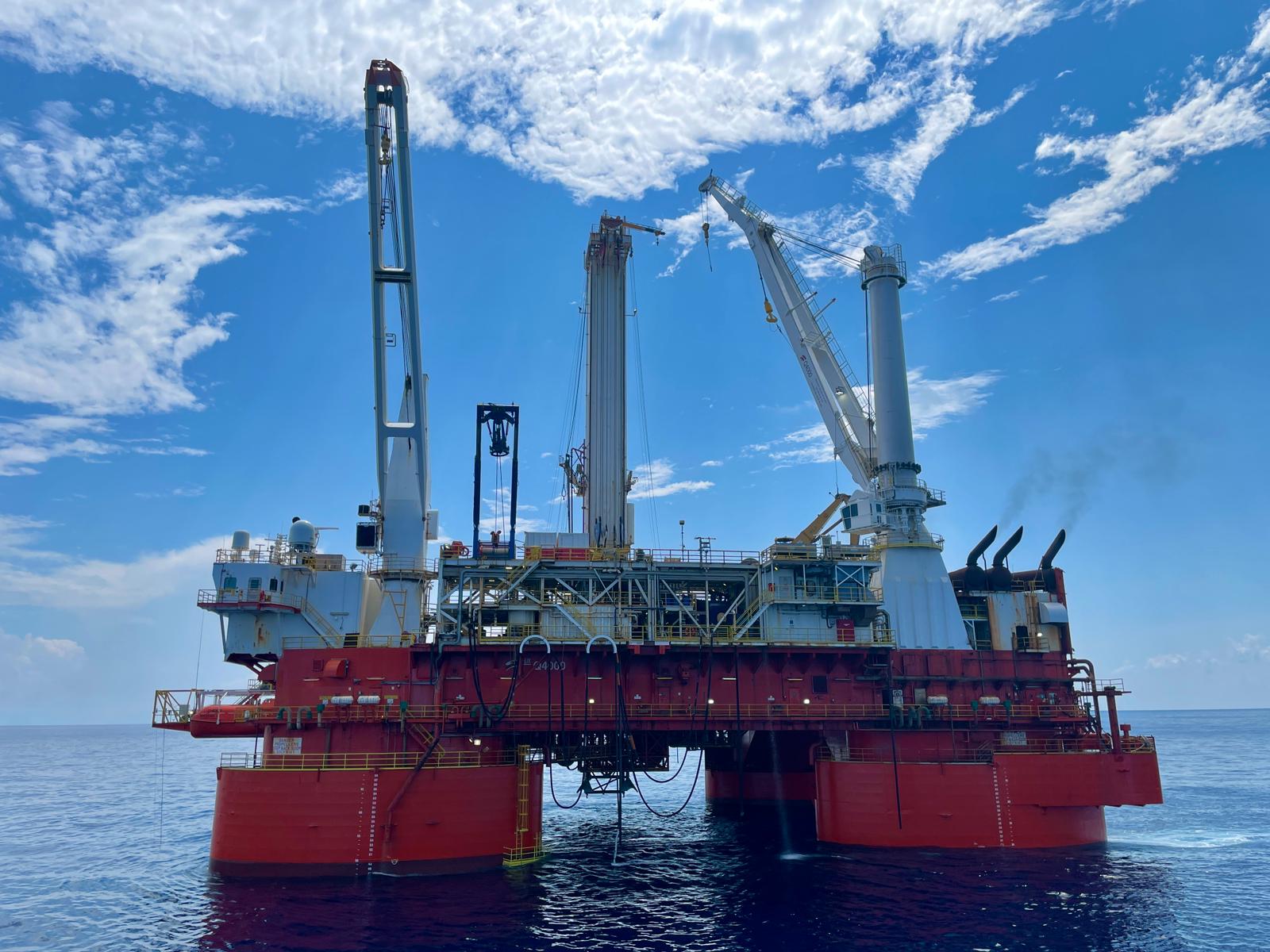
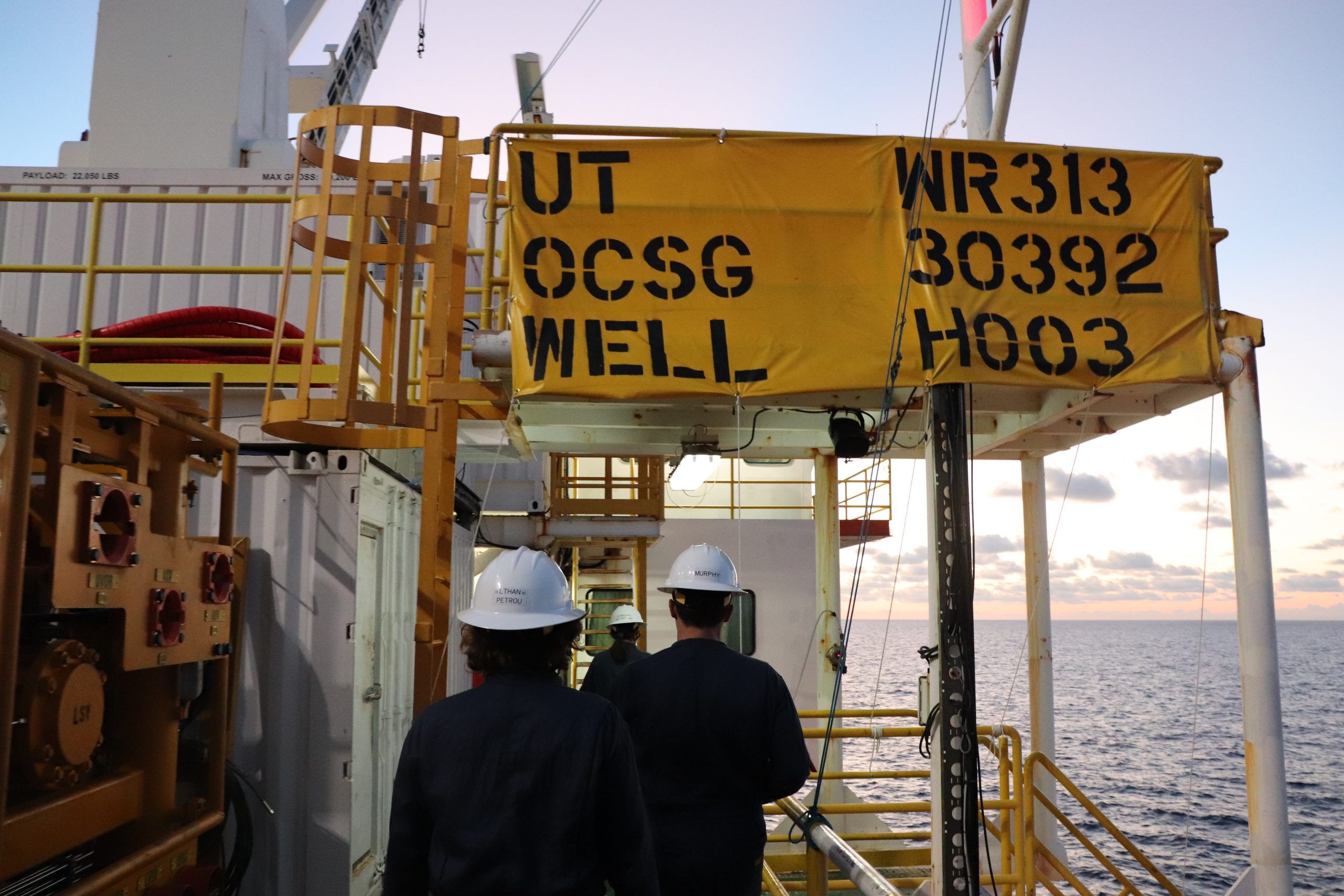
Walker Ridge is just one of many methane hydrate reservoirs found under the seafloor of the Gulf, and around the world. Deposits of the mysterious substance also form beneath ice sheets and Arctic permafrost. Scientists estimate that, collectively, the global supply of hydrates may hold anywhere from 5% to 22% of the Earth’s mobile carbon – the carbon that plays the most immediate role in shaping climate, environment and life on Earth. For comparison, that is up to 10 times as much carbon as what’s in the atmosphere.
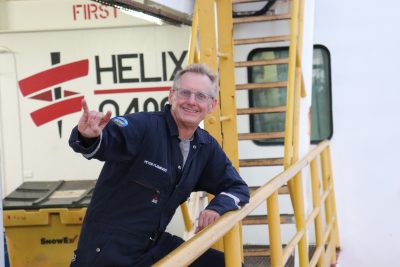
There are big questions about how methane hydrate may shape the energy landscape, with undersea reservoirs potentially holding an untapped supply of natural gas, particularly for energy-poor countries. The solid hydrate is incredibly energy-dense, with each unit of methane hydrate having 165 times the energy of an equivalent volume of gas at surface conditions.
But methane is also a potent greenhouse gas, with emissions that have about 25 times the heat-trapping potential of carbon dioxide. There are big questions here, too, about what conditions may lead the methane to escape from its hydrate cage and seep into the wider world — and the impacts this could have on the environment and climate.
Answering those questions requires getting an up-close look at a methane hydrate reservoir from top to bottom. That’s exactly what the scientific coring mission is seeking to do, according to Jackson School of Geosciences Professor Peter Flemings, the chief scientist on the mission, called UT-GOM2-2.
“One of the amazing things about the University of Texas is that if you say you want to do something really big, they will help you find a way to make it happen,” said Flemings. “There’s no bigger example I can think of than this.”
Joining Flemings offshore is a team of scientific collaborators from four other universities, the U.S. Geological Survey (USGS), and the coring and core analysis company Geotek Coring. That’s not to mention the 108 additional crew members — the cooks, cleaners, drillers, and more — providing support so the mission can run 24 hours a day for a month straight. A mission of this scope and scale is complicated and expensive. Offshore rigs don’t come cheap; it costs half a million dollars a day to keep the Q4000 running. The mission is made possible by a grant of more than $100 million from the U.S. Department of Energy, one of the largest ever awarded to a university. It reflects the importance of methane hydrate — and how much there is to discover about the mysterious, energy-rich substance at the bottom of the sea.
ARRIVAL
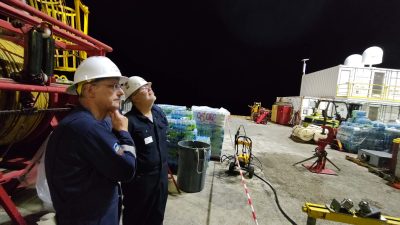
It’s about 11:30 p.m. on a warm summer night. A team of scientists working the night shift has gathered on the deck of the rig to watch the latest core sample come in. Clad in white hard hats, safety glasses and blue coveralls, the scientists tilt their heads toward the sky. The core may come from the depths, but it’s currently lifted in the air, encased in a 29-foot-long drill pipe and carried by a crane. A team of drillers stabilizes the pipe with ropes as the pipe glides across the deck and is lowered into a cradle that’s set up a few feet away from the science team. The scientists keep a safe distance as the drillers prepare to open the pipe. The container is known to spew seawater and sediment as it’s opened. Among the science team on deck this evening is Flemings. He watches closely as the drillers work to free the core sample that’s inside.
A Holistic Look
This summer isn’t the first time Flemings has watched core arrive on the Q4000. In 2017, he led UT-GOM-1, a mission aboard the vessel that extracted the first pressure cores of methane hydrate from the Gulf of Mexico.
The mission, which was funded by the same Department of Energy grant as the current mission, sampled a single reservoir layer about 1,300 feet below the seafloor and successfully retrieved 13 pressure cores that were shipped to a specialized lab at the Jackson School for storage and study. It’s impossible to keep methane hydrate intact unless it’s kept under pressure. If the pressure lessens, the methane escapes, bubbling away. While the cores provided valuable scientific samples, the more important accomplishment, said Flemings, was that it proved that the pressure-coring tool worked.
This success opened the door to a bigger science mission — one that could sample an entire methane hydrate reservoir. Flemings and the science team set their sights on taking cores — both pressurized and conventional — that spanned from the bottom of the seafloor to more than 3,000 feet below it.
“UT-GOM2-1 was a technology test,” said Flemings. “The true science, in terms of a systems understanding of the reservoir, will come from UT-GOM2-2.”
The 24-member, offshore science team includes a wide range of perspectives. There are sedimentologists, microbiologists, geochemists and other cross-disciplinary experts on the team. And while they each come with their own questions about the core and ways of sampling it, the mission plan calls for them to combine what they learn into a holistic understanding of the Walker Ridge reservoir, and an improved understand of methane hydrate in general.
The scientists aboard also have a range of experiences with the stuff.
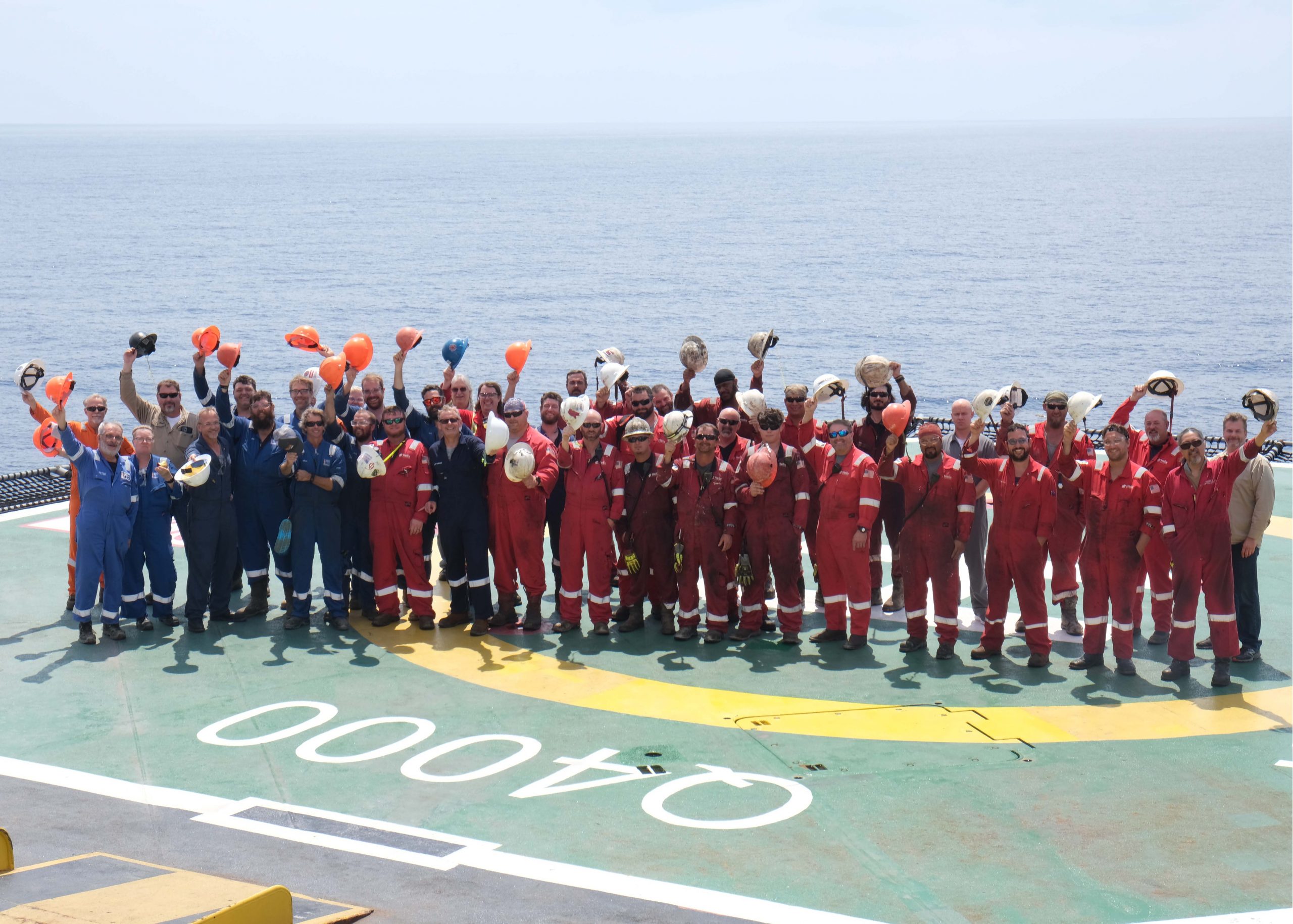
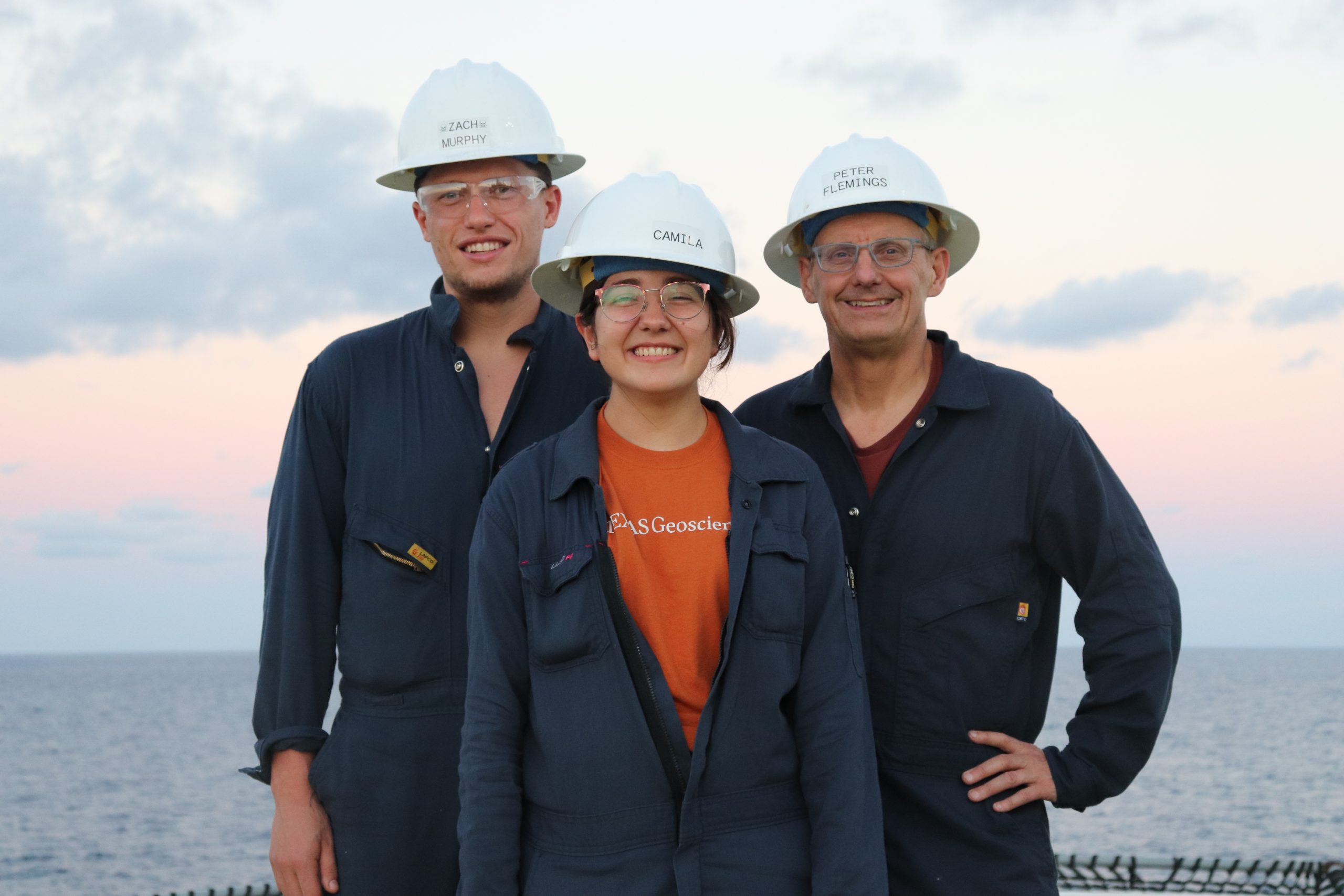
Ann Cook and Tim Collett were both part of a 2009 mission to the Walker Ridge reservoir that drilled two boreholes and collected well log data, which now serves as a guide to where the methane-hydrate-rich layers are located. Cook was a graduate student at the time. Now, 14 years later, she is returning to the reservoir as a full professor at The Ohio State University and the director of undergraduate studies at its School of Earth Sciences.
“I feel so lucky to be here again,” she said.
Collett was then and is still a researcher with the USGS. He is the mission’s general go-to guy for any question about methane hydrate, big or small. He can tell you the location of the coring tool in the drill string, or trace the arc of methane hydrate research stretching back to the 1980s. “Ask Tim” is a common refrain heard around the ship to a range of questions.
The team also includes graduate students and postdoctoral researchers who are new to the world of hydrate research, but who have been recruited by their advisers to lend their research skills. For example, Kelly Shannon, a microbiology graduate student at Oregon State University, is helping search for signs of deep-sea microbes in the core samples by applying DNA sampling and sequencing techniques he has honed studying river microbes in salmon runs.
The mission’s sole undergraduate researcher is Camila Van Der Maal, a first-year geophysics student at the Jackson School. Van Der Maal started working in Flemings’ core lab this spring, degassing pressure cores from the 2017 mission. On this summer’s mission she is working with Shannon and Rick Colwell, a microbiologist and professor at Oregon State, collecting microbiology samples.
Microbiology is new to her, but that can be said about much of this mission. She had never traveled to another state in the U.S. before this mission, let alone taken a helicopter to a rig to conduct science at sea.
“It’s kind of a shock to be here,” she said. “I thought I would need a lot more experience.”
But Flemings said she was ready. “One of the most exciting things I do as an educator is to just give students an opportunity to flourish,” he said. “Ultimately, Camila is a capable person.”
INTAKE
The gray seafloor sediments that make up the core are contained in a clear plastic lining. The drillers pull the core from the pipe and carry it to the core receiving lab — the first stop for all conventional core once it leaves the drilling floor. (The pressure core goes to a different facility for X-ray scanning.)
The lab is in a white shipping container. The drillers insert the core through a small hole cut directly into the container’s side. Awaiting it on the other side are Collett and Peter Schultheiss, the owner of Geotek. They pull the sample in until it disappears from the outside. The core has officially left the world of drilling. It’s a scientific specimen now.
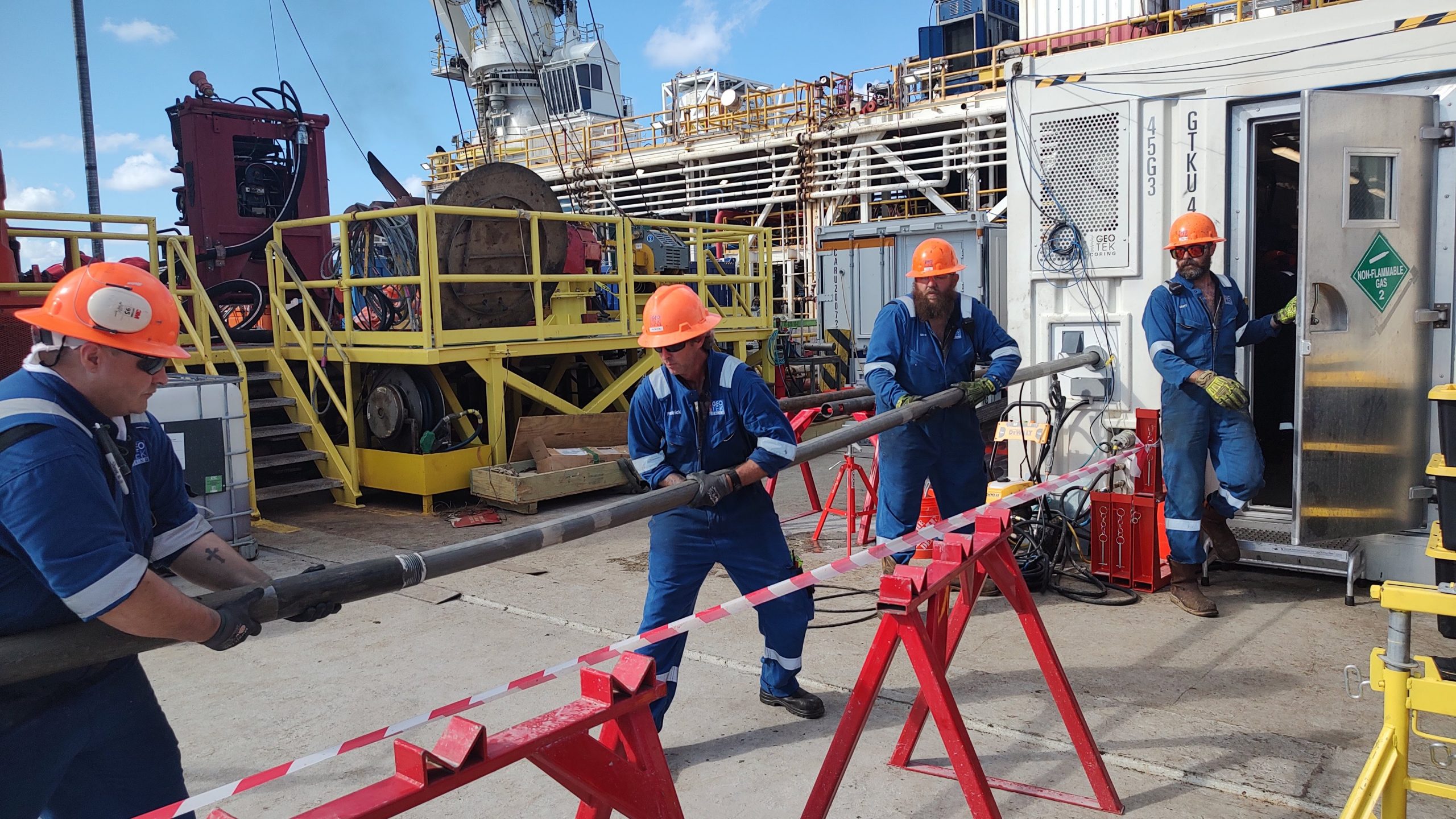
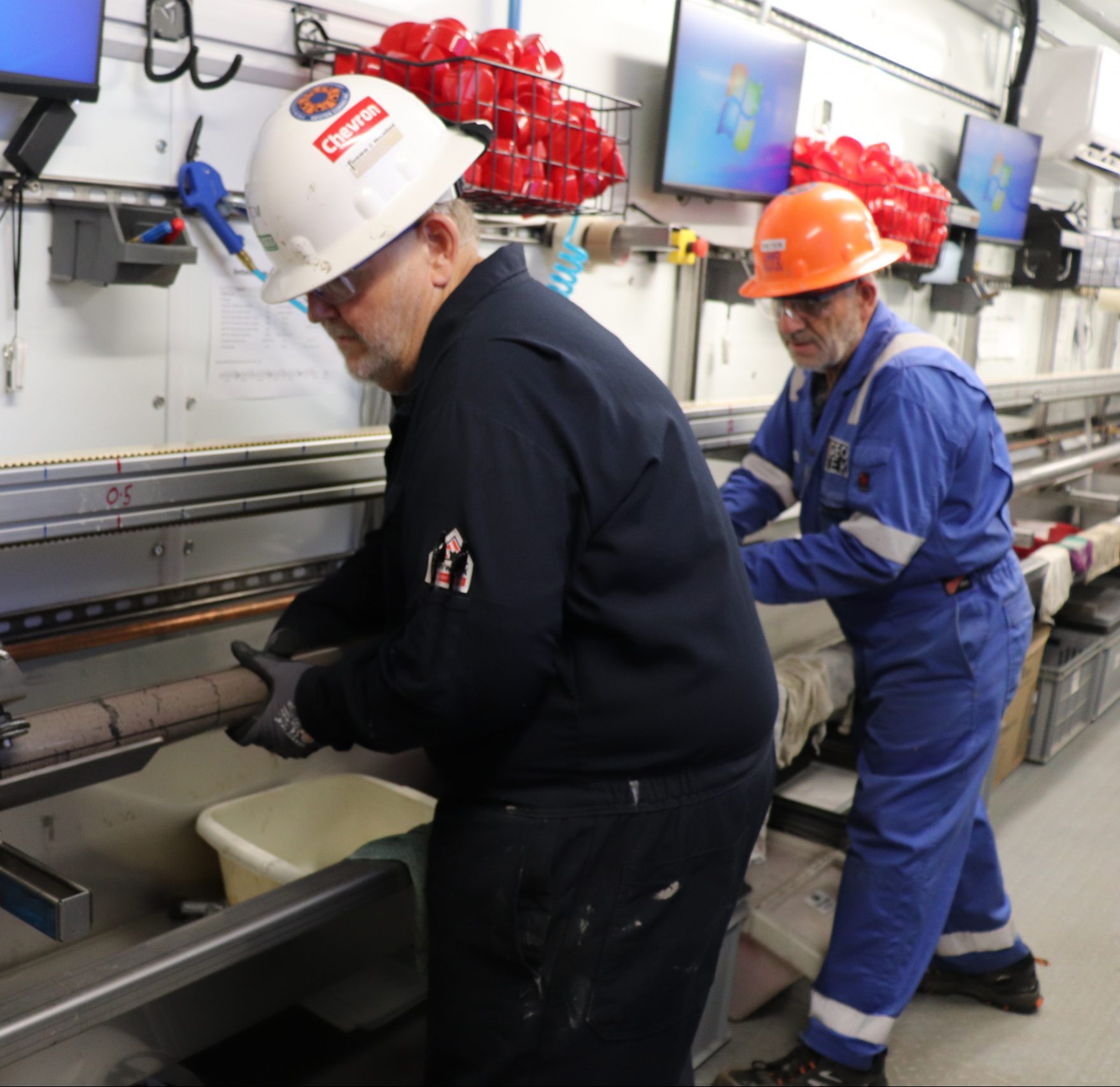
Science Questions
The pressure cores collected during the 2017 mission provided the first chance to study samples of intact methane hydrate from the Gulf of Mexico in the lab. They’ve been the subject of dozens of research papers, including a special bulletin of the American Association of Petroleum Geologists.
According to Flemings, there are two major findings that have come from studying the pressure cores that are guiding the science on this summer’s mission.
The first finding: The 2017 cores were absolutely packed with methane hydrate. The research revealed that 79% to 93% of the pore space between the sand grains in the pressure cores was filled with the frozen gas.
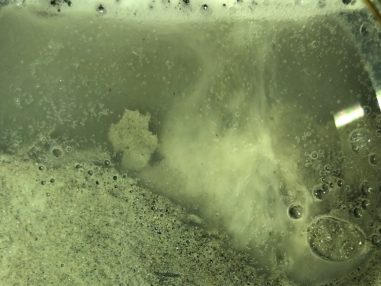
However, despite the high hydrate concentration, it’s unknown where in the subsurface the methane originally came from and how old it is. A major focus of the science team is sampling the gas and pore water in the cores for geochemical clues that can help answer this question for Walker Ridge.
Rachel Coyte, a postdoctoral researcher at The Ohio State University, brought a supply of thin metal tubes for capturing noble gases that can help determine the age of the hydrates captured in the pressure cores. And Evan Solomon, a professor and geochemist at the University of Washington, is collecting pore water by squeezing it from hockey-puck-size samples cut from the core in a large hydraulic press and preserving its chemical constituents so they remain in the same state as they were in the reservoir.
“These chemicals can show the source depth of where the methane came from, where it originated and how it gets into the reservoir,” Solomon said.
The second significant finding from the 2017 cores is that microbes were responsible for making the methane from which the hydrates form. Flemings said this discovery came as a bit of a surprise. The oil and gas deposits in the Gulf of Mexico are the result of thermogenic processes — the slow crushing and heating of dead organic material as it’s piled under tons of sediment over eons.
It was presumed that the methane found in Gulf hydrate would originate from the same processes. But based on the 2017 cores, the methane isn’t produced by the gradual crushing of dead matter but as a byproduct of life in action — generated by microbial metabolism of organic carbon.
The scientists discovered that the methane came from microbes by identifying an isotopic signature in the gas. But for this mission, they’re hoping to find specific microbes that call Walker Ridge home — and to investigate the role they play in both producing methane and consuming it.
Methane-eating microbes — which have been studied in other methane-rich areas of the seafloor — are important for understanding environmental questions about methane hydrate, said Colwell, the microbiology lead, because their microbe-munching ways create a natural environmental filter that keeps large amounts of methane from escaping into the ocean and atmosphere.
“Trying to understand these things is really important to unraveling these hydrate problems,” Colwell said.
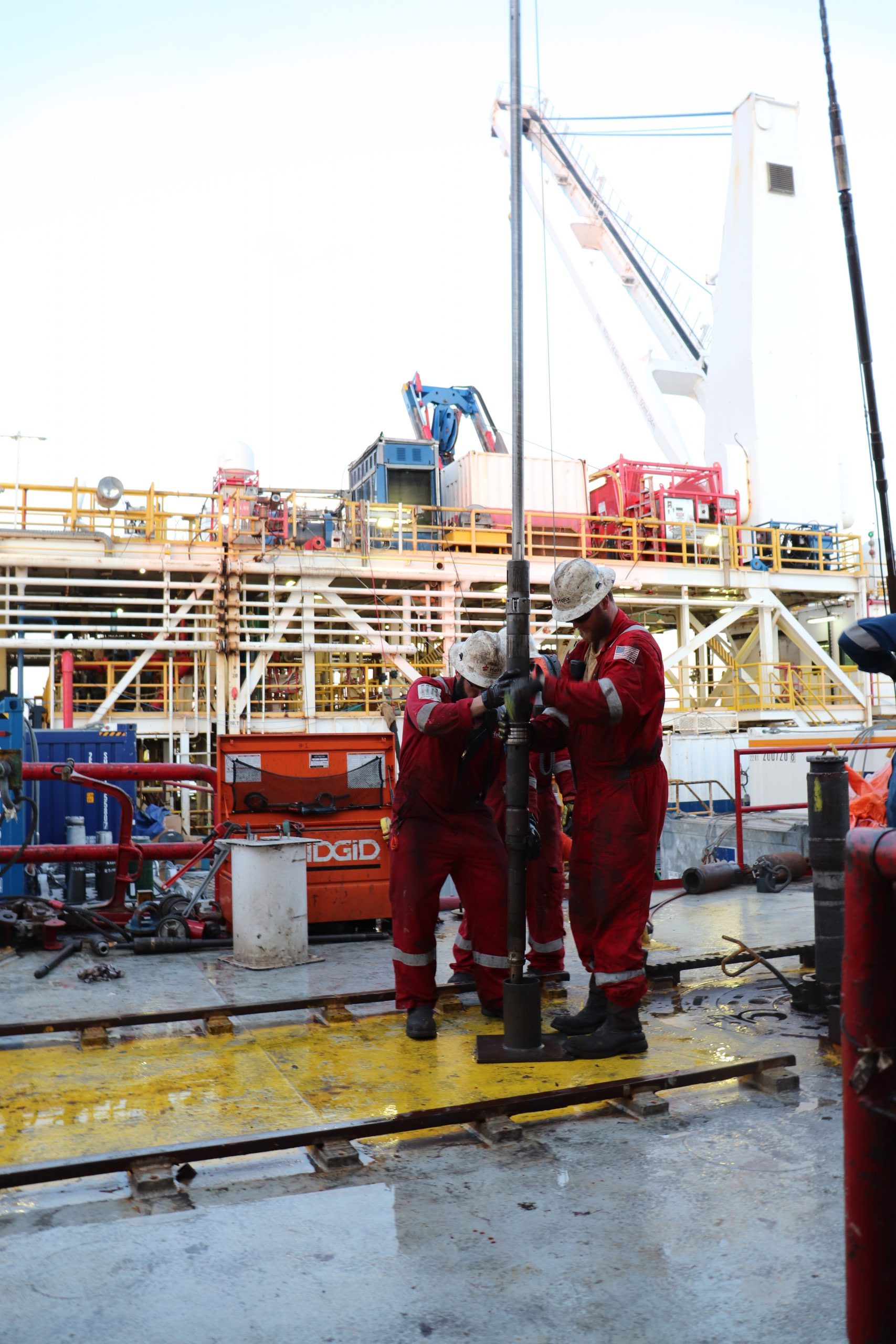
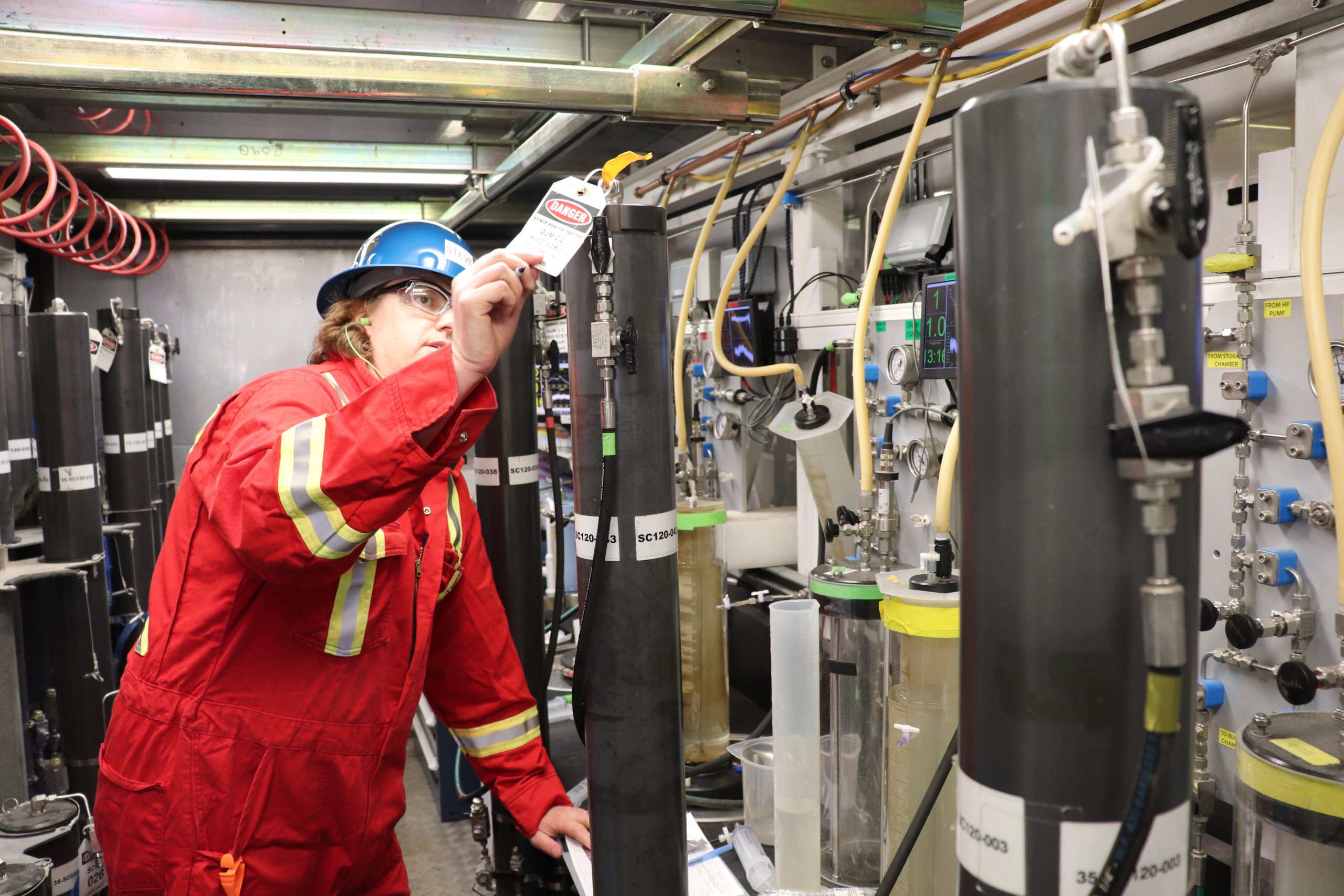
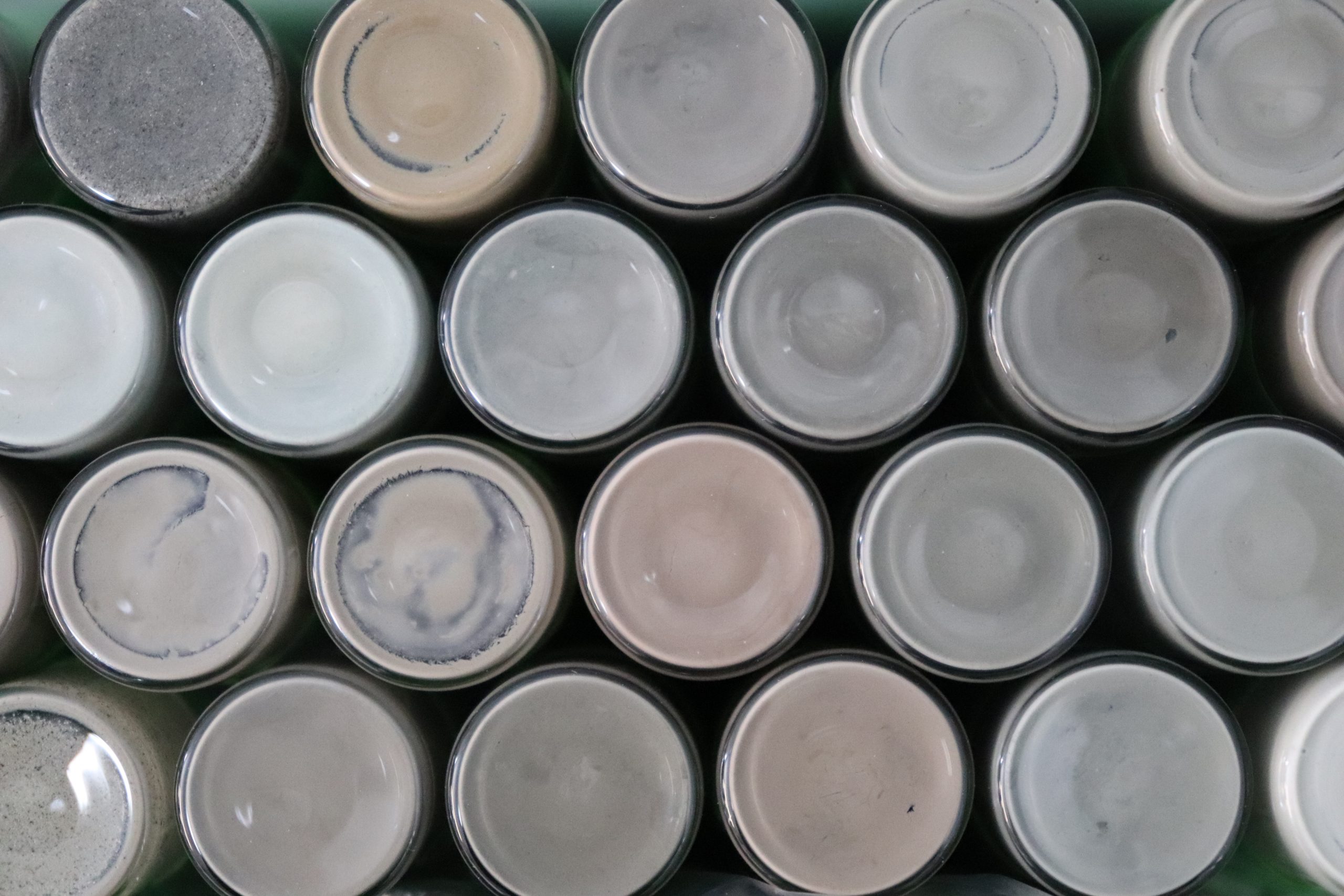
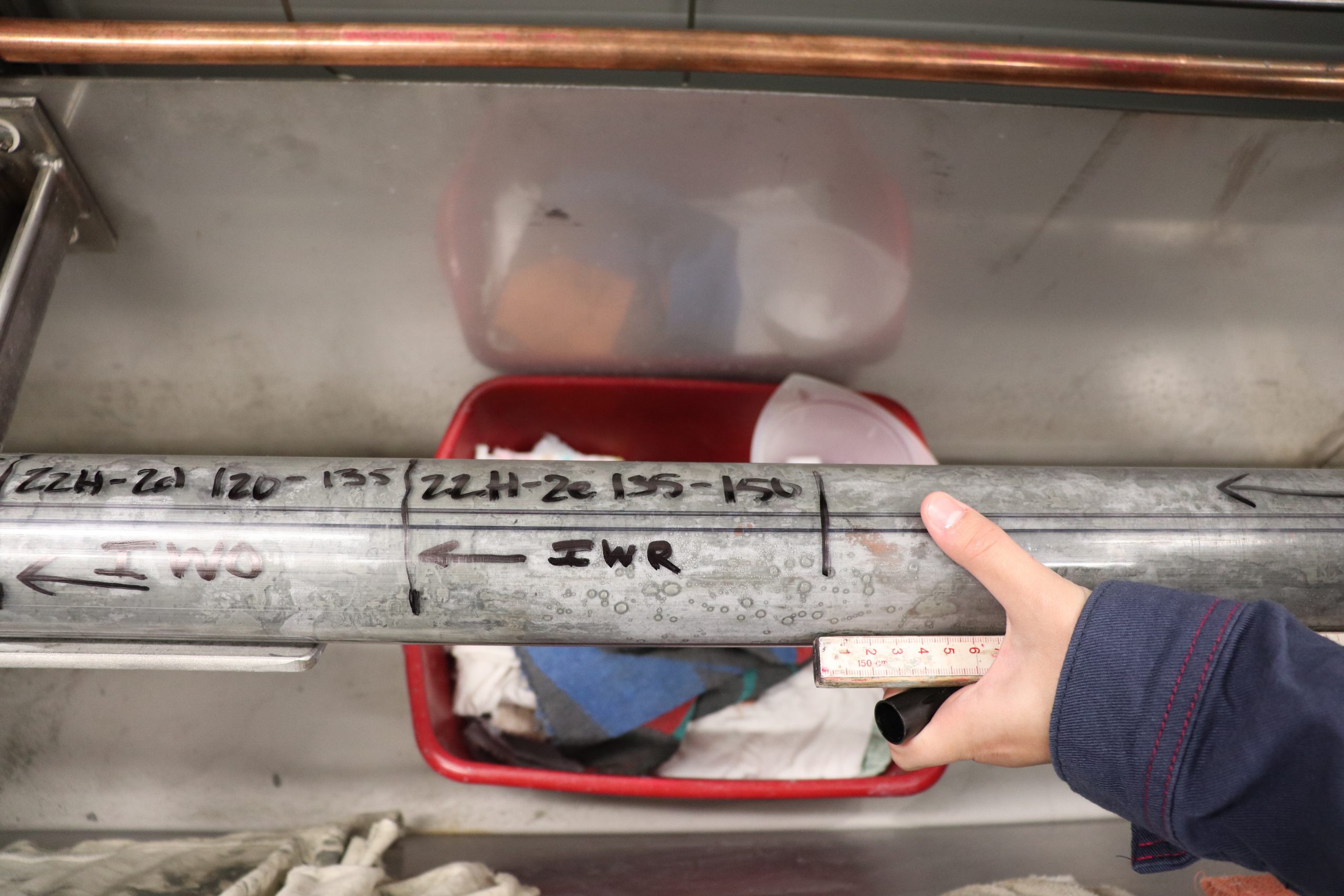
CURATION
Still encased in its liner, the core lies over a metal trough in the core intake lab. An automatic thermal imaging device rolls over it, capturing hidden pockets of methane, and possibly lingering remains of hydrate that may be inside.
Methane gas is found throughout the reservoir system to different degrees. Whether it’s free gas or frozen hydrate is a matter of temperature, pressure, and pore space for the hydrate to fill. The science team is tracking the methane concentration as they drill deeper and deeper down by taking gas samples from each core that surfaces.
The gas collects in large air pockets interspersed throughout the core called voids. Camille Sullivan, a graduate student at the University of New Hampshire, pushes a syringe through the liner into one of these voids and pulls the plunger, inflating a small silver bag with a sample of methane.
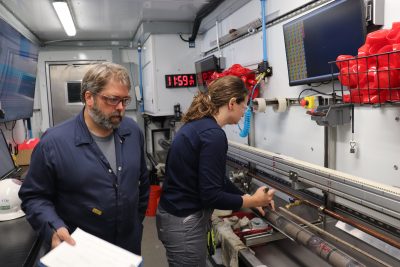
Voids form during the core’s journey to the surface as the gas inside the sediments expands and escapes under the reduced pressure. They’re a reminder of how the core is acclimating to its new surface conditions. While the pressure cores are preserved in the same conditions they existed at in the reservoir, the more time the conventional cores spend on deck, the less they resemble the seafloor. The gas leaves. The microbes mingle. The scientists must work quickly to take samples before they change too much.
Cook marks the core lining with a permanent marker — flagging voids for sampling and portions to be sent off to the other labs, housed in smaller shipping containers on deck, arranged in what Cook describes as a “jigsaw puzzle trailer park.” But most of the core is left untouched. It will be split and analyzed during the onshore portion of the mission happening in Salt Lake City after the conclusion of the offshore portion of the mission. This second phase of the mission will draw about a dozen additional collaborating scientists from around the world, eager to see what the cores contain and collect samples that could help advance their own methane hydrate research.
Early Discoveries
Even though the offshore sampling is providing only a cursory look inside the core samples compared with what will happen onshore, the science team has still found some tantalizing clues that offer a glimpse of the inner workings and history of the methane hydrate reservoir below.
Solomon has found streaks of black iron sulfide in a core sample that might mark the past location of the layer of methane-consuming microbes. He also found a sign of where they might exist today in the form of a finger-nail-size clump of pink slime, which Colwell was particularly excited about. The slime served as a good sign that there would be rich microbial communities to sample near the top of the reservoir.
Joel Johnson, a sedimentologist and professor at the University of New Hampshire, is also excited about an X-ray from the pressure core lab. The X-ray image showed a core composed of perfect stripes of millimeter-wide layers of sediment. Its pristine appearance could indicate that the sediment was deposited at a time when the bottom of the ocean was anoxic and unable to support abundant sea life, like clams and worms, which usually leave their mark in sediment cores in the form of burrows. This low-oxygen environment could have also produced some of the black iron sulfide that Solomon spotted.
“Core can help confirm science or refute it,” Solomon said. “There’s always something that we pull up in a new core that is fun or exciting.”
Alejandro Cardona, a research associate at the Jackson School, said that it’s inspiring to see new core samples just about every day.
“On land, when you see a rock, it’s something that perhaps many other people have seen before,” he said. “However, out here, we’re accessing a location that’s 2 kilometers deep in the water, and we are the first to see these cores.”
Mission progress and findings are discussed at daily science meetings run by Flemings and Collett. But informal discussions are happening between scientists all the time — over hearty meals, while lacing up steel-toed boots, or taking a moment to watch schools of flying fish glide over the waves.
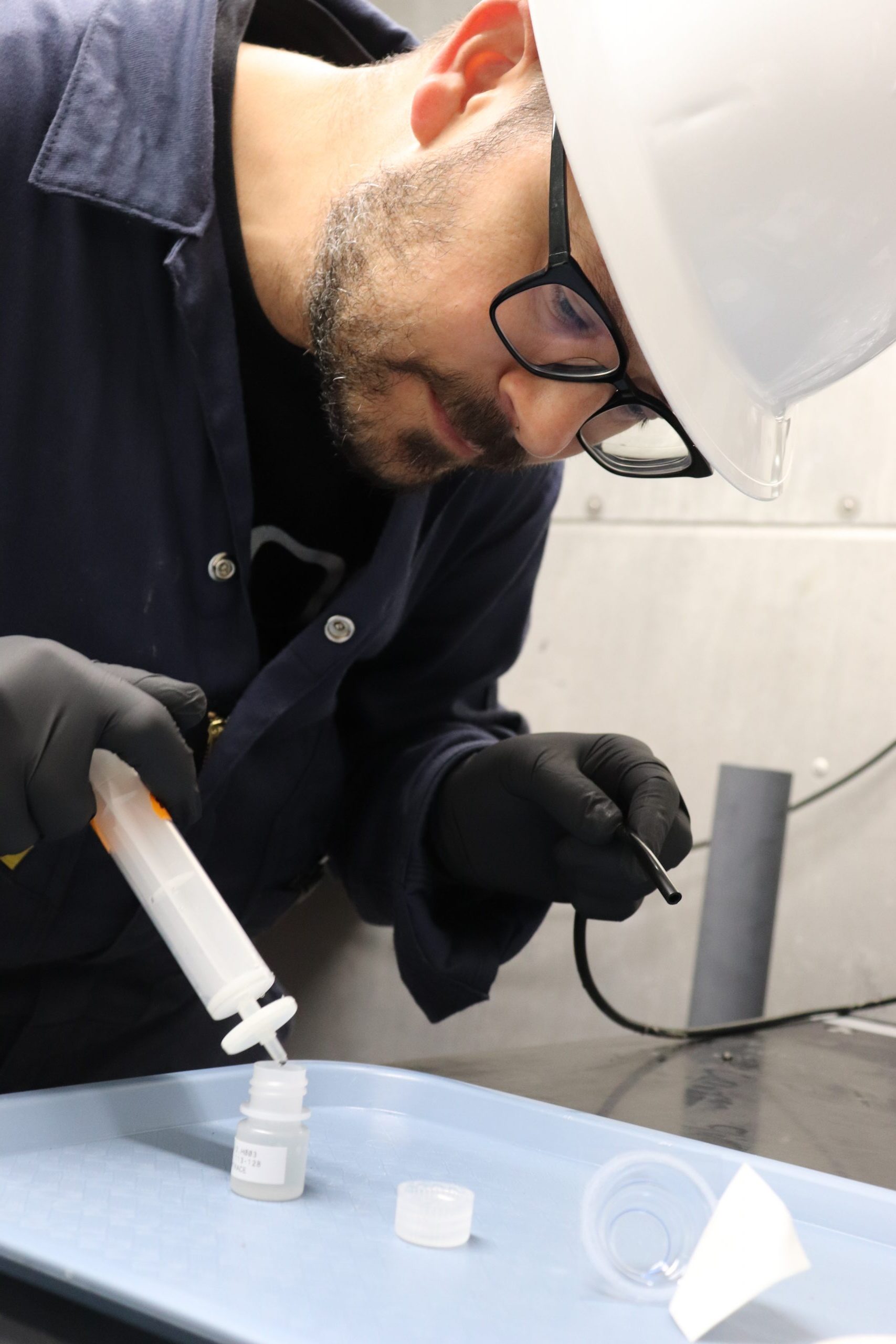
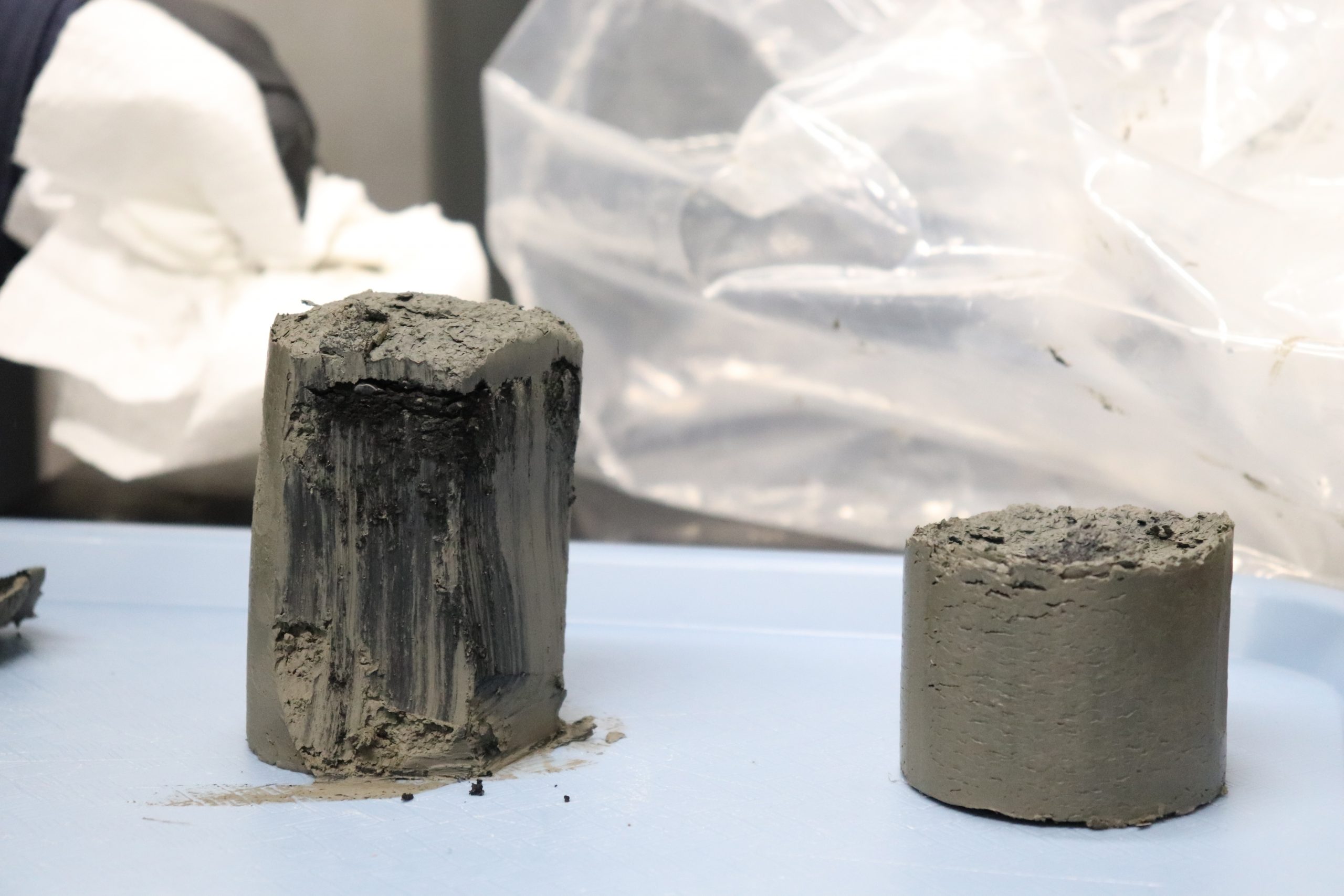
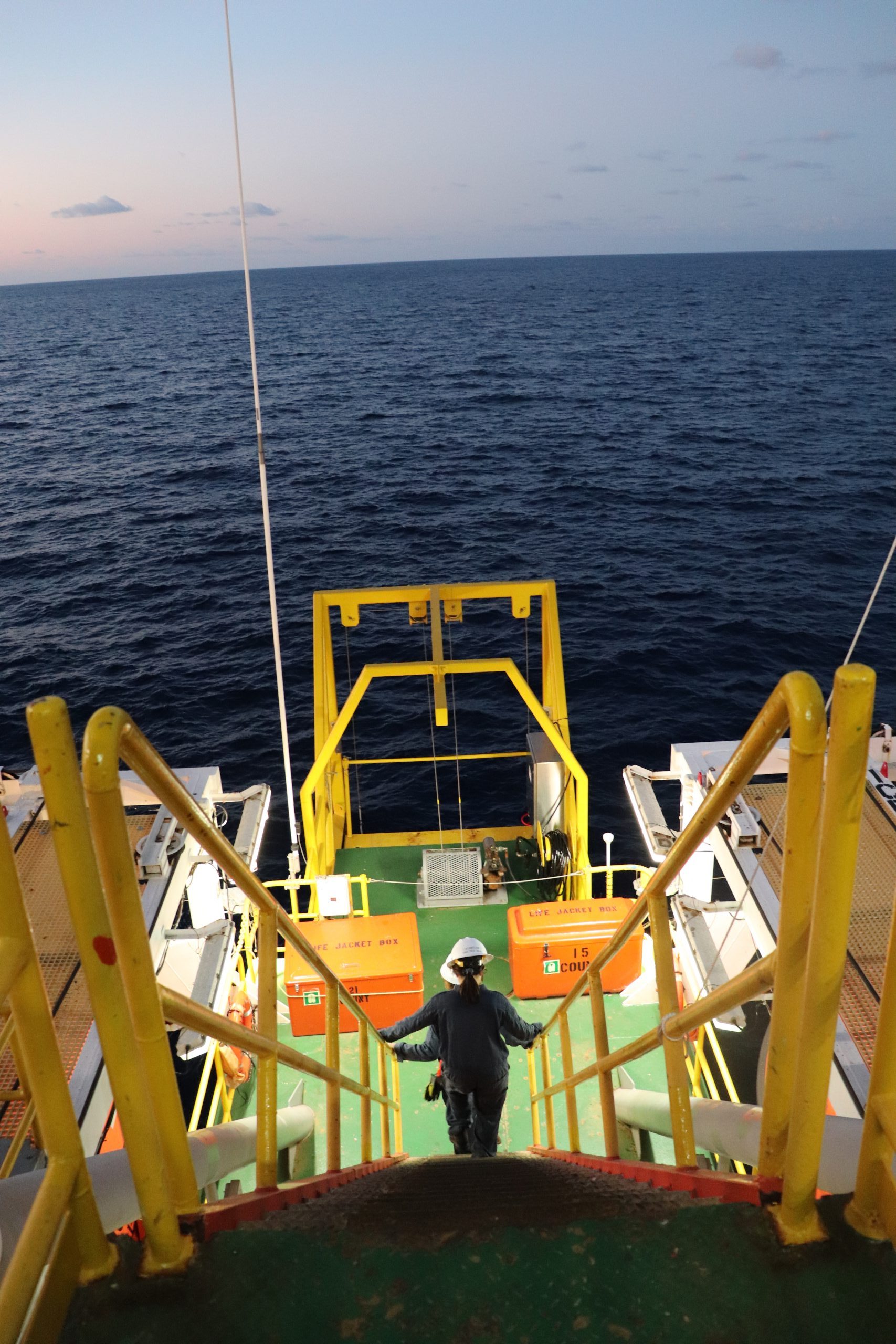
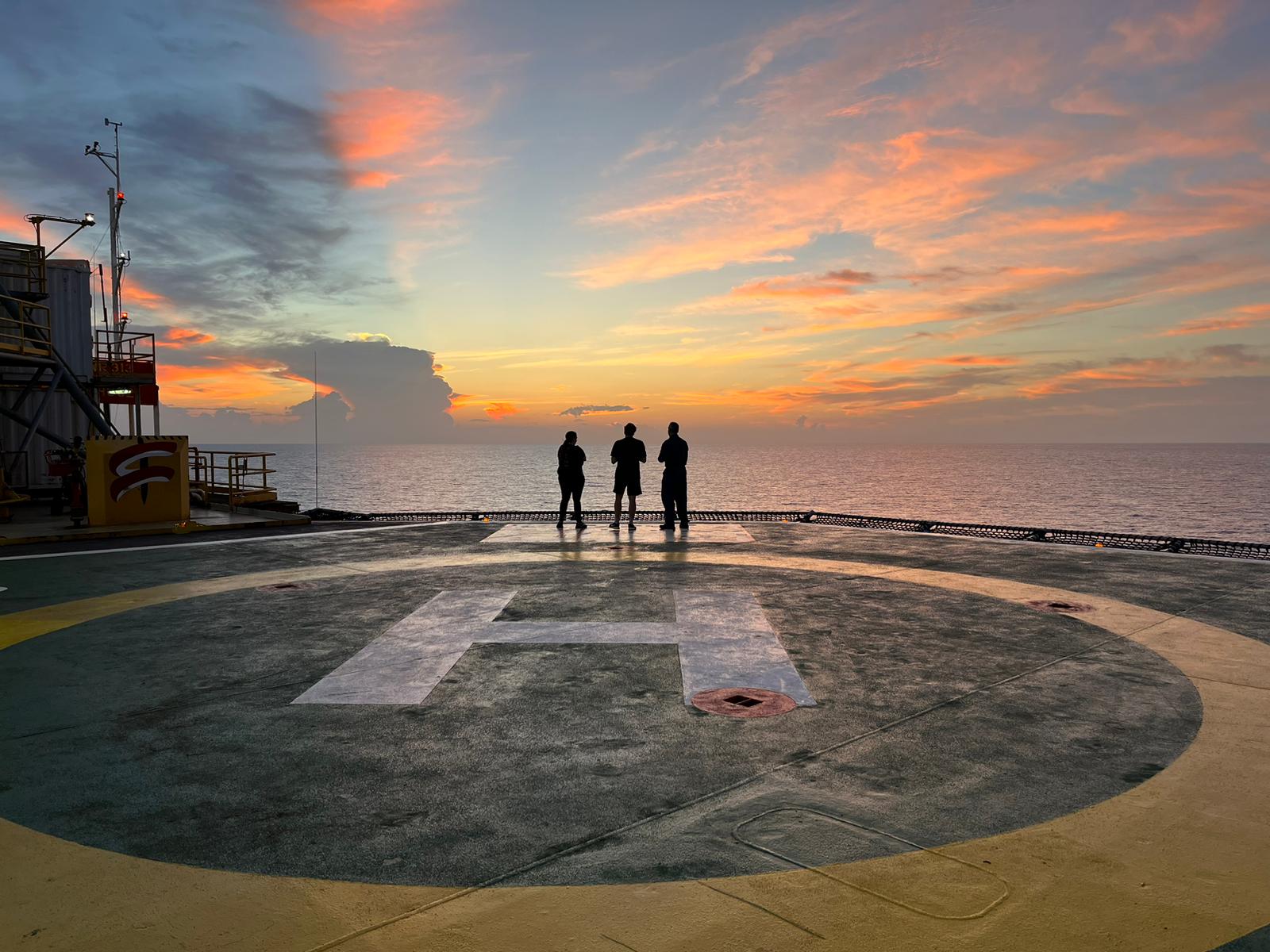
For Van Der Maal, these discussions have offered critical insight into the institutional side of science — the stuff that isn’t covered in class but that is nevertheless essential to know, from how to find grants and what they cover, to summer research opportunities. At the same time, the team is making sure she is keeping up with the basic science of the mission, too.
During their first week at sea, Flemings had her create a chart plotting methane hydrate stability, the temperature and pressure conditions under which hydrate forms and dissolves. Jackson School graduate student Zachary Murphy gave her two assignments on methane hydrate physics pulled from a graduate-level course. The assignments proudly hang on the rig’s office minifridge, both marked with a bright red A+. “She will never forget what the hydrate stability barrier is, solving these problems out here,” Flemings said. However, Van Der Maal almost wasn’t part of the mission — or part of the Jackson School, for that matter.
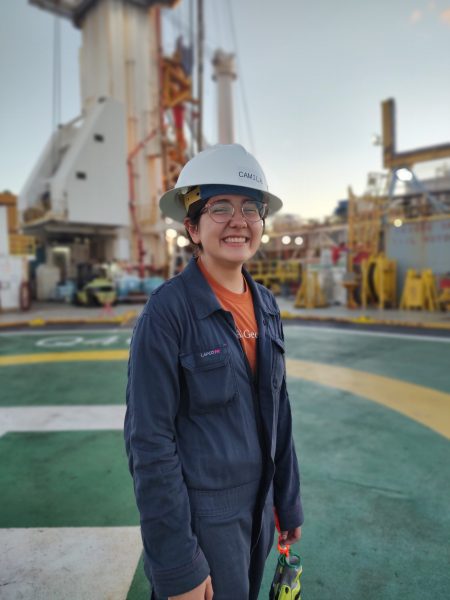
While finishing high school remotely during the pandemic, Van Der Maal said she became burned out by college preparation classes and was having second thoughts about going to college at all. That changed after she learned about the scientific cruises led by researchers at the Jackson School’s Institute for Geophysics. She had dreams of going on a scientific mission to Antarctica. She decided to apply to the Jackson School in hopes of working her way onto one.
Although the Gulf of Mexico isn’t exactly the South Pole, she said the methane hydrate mission provides exactly the challenge and adventure that her dream of Antarctic cruises inspired. In her downtime, she has been working with Cook on a project proposal that can hopefully land her a spot on an upcoming scientific drilling mission happening in New England next year.
“I’ve learned so much from everyone out here,” she said. “I can’t wait to get back offshore.”
Physical Science
Once the core is on deck, sampling follows a scientific protocol, set in place by the science team months in advance. But when it comes to extracting the core, it’s a matter of responding to on-the-ground conditions. The swell of the sea bends the drill string, affecting drilling depth and the angle the pipes enter into the reservoir. The sticky subsurface sediments often grip the coring tool and won’t let go without a fight.
Flemings and Thomas “TR” Redd, the vessel’s “company man,” who serves as a liaison between the science team and the drillers, are often working out how to overcome coring problems in the moment. The two frequently can be spotted heading back and forth between the rig office and the “dog house,” the control room for drilling machinery located just behind the drilling floor.
“Taking core is a mechanical effort,” Flemings said one afternoon, standing near the drilling floor as drillers pulled a pipe containing the coring tool from the deck. “There are no automated locks or robots to put pipe into position. It’s human labor and heavy machinery.”

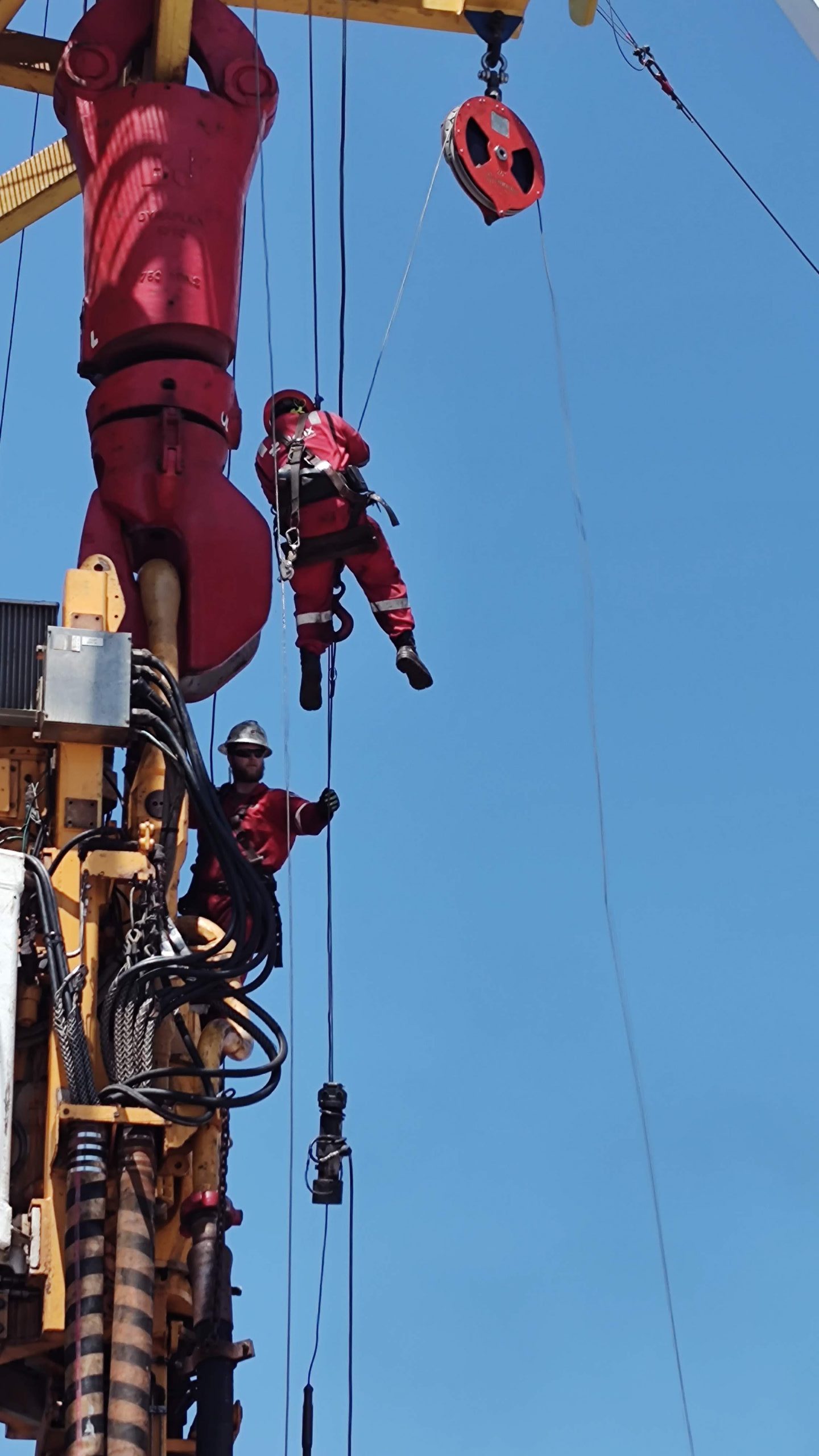
For the first week of the mission, the team overcame all the coring curve balls and hurdles. The drilling and coring progressed. But at about 500 feet down, operations suddenly came to a standstill.
An essential piece of coring equipment, the fan motor on the top drive, had broken down. That same day, the vessel’s captain announced that cases of COVID-19 had sent a couple of members of the science team and the drill team into quarantine. The mission would continue. They would just have to wait out repairs and COVID-19 cases.
“It’s a pendulum situation right now,” Flemings said. “We’ll see how it goes and deal with it.”
In an age of digital models and automatic algorithms, this mission illustrates how pioneering science about the planet is still very much a physical process. There is no other way to get methane hydrate cores than to drill thousands of feet below the seafloor. When obstacles arise, the only way out is through.
In the midst of these issues, Flemings sent an email to the offshore science party, emphasizing the difficulty of their mission, the challenges they have overcome so far, and all they have left to do.
“Be patient…we will get there,” he wrote. “You are doing great things. I am proud to be here with you.”
A couple of days later, the cores were coming up the drill string again. The journey into the depths of the reservoir continued on, as the scientific discoveries it produces will — for years to come.
MORE METHANE HYDRATE |
|
WATCH: The Mystery of Methane HydrateA film by the Jackson School of Geosciences about the 2023 mission to sample a methane hydrate reservoir in the deepwater Gulf of Mexico. |
|
READ: Mission BlogLearn more about the day-by-day happenings of the methane hydrate mission from a blog by Monica Kortsha, the assistant director of communications at the Jackson School of Geosciences, who spent a week embedded with the science team aboard the Q 4000. |
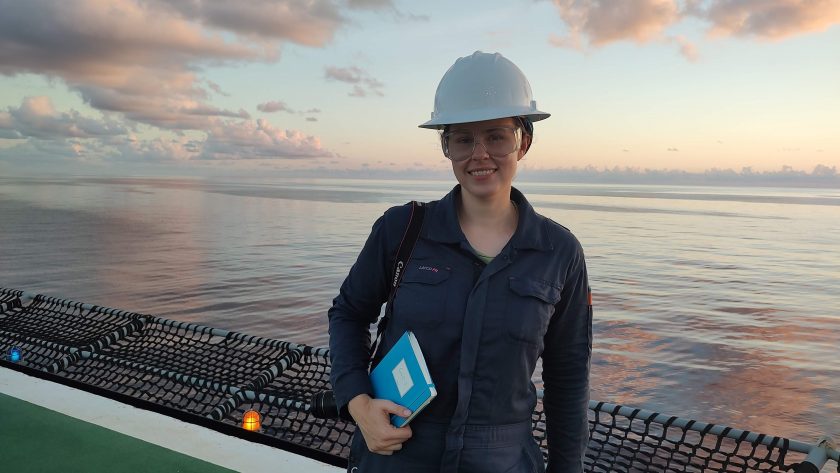 |
The University of Texas at Austin
Web Privacy | Web Accessibility Policy | Adobe Reader

